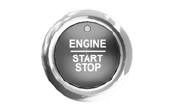Ford Escape: Exhaust System / Diagnosis and Testing - Exhaust System
Global Customer Symptom Code (GCSC) Chart
Diagnostics in this manual assume a certain skill level and knowledge of Ford-specific diagnostic practices.
REFER to: Diagnostic Methods (100-00 General Information, Description and Operation).
| Symptom | Action |
|---|---|
| Fit/Finish/Body > Paint/Finish > Exhaust > Corrosion/Rust | GO to Pinpoint Test C |
| Start/Run/Move > Noise > Exhaust > Always | GO to Pinpoint Test D |
| Driving Performance > Lack/Loss of Power > Acceleration > Always | GO to Pinpoint Test A |
| Safe & Secure > Smoke/Odor > Exhaust > Hot | GO to Pinpoint Test B |
Symptom Chart(s)
Symptom Chart - Exhaust System
NOTE: Aftertreatment components consist of some or all of the following components: Catalytic Converters, Gasoline Particulate Filters, Diesel Particulate Filters, Selective Catalytic Reduction Catalysts, Exhaust Gas Heat Exchanger.
Diagnostics in this manual assume a certain skill level and knowledge of Ford-specific diagnostic practices.
REFER to: Diagnostic Methods (100-00 General Information, Description and Operation).
Symptom Chart
| Condition | Actions |
|---|---|
| Lack of power - vehicle performance complaint |
|
| Odour from vehicle - possible sign of smoke |
|
| Surface rust or degradation of surface treatment |
|
| Noise such as buzzing, drumming, thumping, ringing or hissing coming from exhaust system |
|
Pinpoint Tests
.jpg) PINPOINT TEST A: LACK OF POWER
PINPOINT TEST A: LACK OF POWER|
NOTE: Aftertreatment components consist of some or all of the following: Catalytic Converters, Gasoline Particulate Filters, Diesel Particulate Filters, Selective Catalytic Reduction Catalysts. Normal Operation and Fault Conditions
REFER to: Exhaust System - System Operation and Component Description (309-00C Exhaust System, Description and Operation). Possible Sources
Visual Inspection and Pre-checks
|
||||
| A1 CHECK THE EXHAUST SYSTEM FOR SIGNS OF DAMAGE | ||||
Is damage to the aftertreatment components and associated sensors found?
|
||||
| A2 CHECK THE EXHAUST SYSTEM FOR OBSTRUCTIONS OR RESTRICTED FLOW | ||||
Is any flow restricting damage to the exhaust components seen?
|
.jpg) PINPOINT TEST B: ODOUR FROM VEHICLE
PINPOINT TEST B: ODOUR FROM VEHICLE|
NOTE: Aftertreatment components consist of some or all of the following: Catalytic Converters, Gasoline Particulate Filters, Diesel Particulate Filters, Selective Catalytic Reduction Catalysts. Normal Operation and Fault Conditions
REFER to: Exhaust System - System Operation and Component Description (309-00C Exhaust System, Description and Operation). Possible Sources
Visual Inspection and Pre-checks
|
||||
| B1 CHECK FOR DAMAGED AFTERTREATMENT COMPONENTS ASSOCIATED SENSORS | ||||
Have the aftertreatment components or associated electronic sensors incurred damage?
|
||||
| B2 CHECK FOR INCORRECT FUEL OR FUEL WITH A HIGH SULFUR CONTENT | ||||
Does the fuel tank contain incorrect fuel or fuel high in sulfur content?
|
||||
| B3 CHECK FOR CORRECT PCM (POWERTRAIN CONTROL MODULE) OPERATION | ||||
Are the powertrain controls operating correctly?
|
.jpg) PINPOINT TEST C: SURFACE RUST OR DEGRADATION OF SURFACE TREATMENT
PINPOINT TEST C: SURFACE RUST OR DEGRADATION OF SURFACE TREATMENT|
NOTE: Surface rust is a characteristic of materials used on exhaust systems. Exposure to heat or road salt may result in surface rust. Normal Operation and Fault Conditions
REFER to: Exhaust System - System Operation and Component Description (309-00C Exhaust System, Description and Operation). Possible Sources
Visual Inspection and Pre-checks
|
||||
| C1 CHECK THE EXHAUST SYSTEM FOR PERFORATIONS, RUST OR DAMAGE | ||||
Are perforations, rust or damage present?
|
||||
| C2 CHECK FOR CORRECT PCM (POWERTRAIN CONTROL MODULE) OPERATION | ||||
Are the powertrain controls operating correctly?
|
.jpg) PINPOINT TEST D: NOISE FROM EXHAUST SYSTEM
PINPOINT TEST D: NOISE FROM EXHAUST SYSTEM|
NOTE: Aftertreatment components consist of some or all of the following: Catalytic Converters, Gasoline Particulate Filters, Diesel Particulate Filters, Selective Catalytic Reduction Catalysts. Normal Operation and Fault Conditions
REFER to: Exhaust System - System Operation and Component Description (309-00C Exhaust System, Description and Operation). Possible Sources
Visual Inspection and Pre-checks
|
||||
| D1 CHECK THE EXHAUST SYSTEM FASTENERS | ||||
Was exhaust noise still present after confirming all exhaust system fasteners are tightened to specification?
|
||||
| D2 INSPECT THE EXHAUST ISOLATORS AND HANGER BRACKETS | ||||
Were exhaust system isolators and hanger brackets found to be in correct alginment and in good condition?
|
||||
| D3 CHECK FOR MISSING OR DAMAGED EXHAUST HEAT SHIELDS | ||||
Were the exhaust heat shields found to be present and in correct alignment?
|
||||
| D4 CHECK THE EXHAUST SYSTEM FOR ALIGNMENT | ||||
Was the exhaust noise seen to originate from contact between the exhaust system and the surrounding components/vehicle body?
|
||||
| D5 CHECK THE EXHAUST SYSTEM FOR INTERNAL DAMAGE | ||||
Was noise such as rattling, clanging or twanging heard within the exhaust components?
|
||||
| D6 CHECK THE EXHAUST SYSTEM FOR LEAKS | ||||
Were leaks found?
|
||||
| D7 CHECK FOR COOL DOWN PINGING | ||||
Was the exhaust complaint found to be cool down pinging?
|
 Diagnosis and Testing - Catalyst System
Diagnosis and Testing - Catalyst System
Diagnostic Trouble Code (DTC) Chart
Diagnostics in this manual assume a certain skill level and knowledge of Ford-specific diagnostic practices. REFER to: Diagnostic Methods (100-00 General Information, Description and Operation)...
 Removal and Installation - Catalytic Converter
Removal and Installation - Catalytic Converter
Special Tool(s) /
General Equipment
Wooden Block
Removal
NOTE:
If the catalytic converter is not being replaced, the HO2S
and the catalyst monitor sensor do not need to be removed from the
catalytic converter...
Other information:
Ford Escape 2020-2025 Service Manual: Removal and Installation - Rear Wheel Speed Sensor - FWD
Materials Name Specification Motorcraft® Metal Brake Parts CleanerPM-4-A, PM-4-B, APM-4-C - Removal NOTE: Removal steps in this procedure may contain installation details. Remove the wheel and tire. Refer to: Wheel and Tire (204-04A Wheels and Tires, Removal and Installation)...
Ford Escape 2020-2025 Service Manual: Removal and Installation - Driver Side Instrument Panel Speaker
Special Tool(s) / General Equipment Interior Trim Remover Removal Position the speaker and grille up as an assembly. Use the General Equipment: Interior Trim Remover Disconnect and remove the speaker and grille as an assembly...
Categories
- Manuals Home
- 4th Generation Ford Escape Owners Manual
- 4th Generation Ford Escape Service Manual
- General Procedures - Brake Service Mode Activation and Deactivation
- Electric Parking Brake
- Power Outlet - Vehicles With: 12V Power Outlet
- New on site
- Most important about car
Push Button Ignition Switch

Switching the Ignition Off
When the ignition is on or in accessory mode, press the push button ignition switch once without your foot on the brake pedal.

 PINPOINT TEST A: LACK OF POWER
PINPOINT TEST A: LACK OF POWER